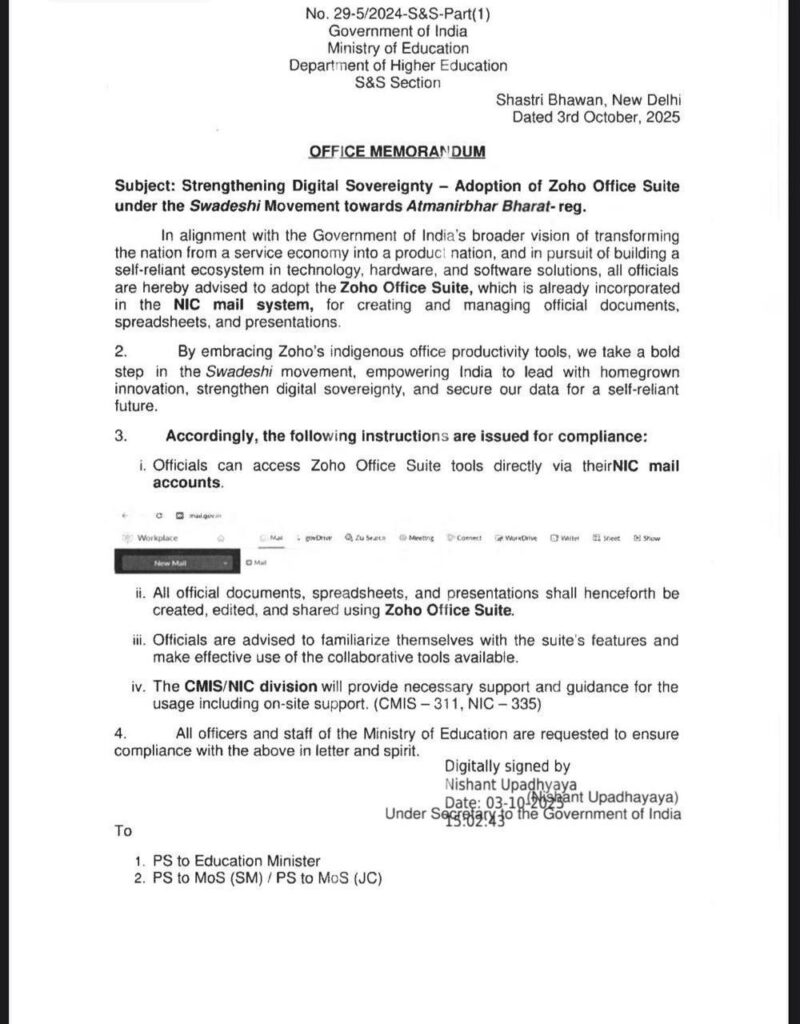The Digital Sovereignty Revolution: How India’s Government Technology Shift is Rewriting Employee and Citizen Experience
Imagine a government employee at their desk, seamlessly creating official documents, collaborating with colleagues, and securing sensitive data—confident that their work supports the nation’s digital independence. This is not a projection for the future; it’s happening right now across India’s Ministry of Education offices. It’s all about Digital Sovereignty.
In October 2025, India’s government made a bold move whose effects will ripple far beyond public sector corridors. The Ministry of Education officially mandated the adoption of Zoho Office Suite for all official work, marking a historic shift in the country’s journey toward digital sovereignty. This change is more than a software upgrade—it’s a live example of how technology choices redefine the way employees work, how organizations operate, and how nations protect their interests.
The Strategic Foundation of Digital Independence
The official memorandum from the Ministry draws a clear line in the sand: “By embracing Zoho’s indigenous office productivity tools, we take a bold step in the Swadeshi movement, empowering India to lead with homegrown innovation, strengthen digital sovereignty, and secure our data for a self-reliant future.” These words capture a major transformation in how Indian offices—and one day, global governments—are rethinking dependencies on foreign technology.
Digital sovereignty has moved front and center for governments globally. It’s increasingly clear that technology independence supports national security, economic growth, and citizen trust. India’s Atmanirbhar Bharat (“self-reliant India”) initiative now uses strategic technology adoption to enhance employee experience, boost operational reliability, and build resilience for the future.
Transforming Employee Experience Through Indigenous Innovation
The Human Impact of Technology Choices
Many government workplaces are burdened by legacy office tools that hinder collaboration, slow processes, and heighten data security risks. Switching to an Indian-built suite like Zoho isn’t just about ticking a box for “Swadeshi”—it solves real problems facing the public sector.
Surveys show government leaders recognize the urgency of change. More than 85% believe they must provide modern digital experiences for the rising wave of Millennial and Gen Z talent joining public service. Tools like Zoho, well-integrated with India’s existing NIC mail system, offer instant, friction-free access for thousands of officials. The result: less time wasted on technical hurdles, more spent serving citizens and supporting national goals.
Digital Confidence and Employee Engagement
Switching from imported technology to homegrown innovation has a notable psychological impact. Employees who use Indian-built tools report increased pride, engagement, and even a stronger sense of purpose in their daily work. This intangible benefit is often overlooked but becomes a powerful driver for technology adoption.
Zoho brings together Writer for documents, Sheet for spreadsheets, Show for presentations, and WorkDrive for secure storage. Employees get the modern features they expect, wrapped in platforms that represent national capability. The blend of function and principle means productivity rises—and so does morale.
Operational Excellence Through Technology Alignment
Cost Efficiency and Strategic Resource Allocation
Money matters—especially for public sector IT budgets. Indigenous solutions like Zoho offer governments significant cost savings over foreign brands, slashing licensing fees while retaining value in the domestic economy. The ripple effect: funds saved on software can be invested in training, infrastructure, or new citizen-facing projects.
Simplified licensing and reduced dependency on foreign technical support lead to faster troubleshooting and more predictable budgets. Departments can plan their operations without worry about opaque contracts or vendor lock-ins.
Security and Compliance Unlocked
Data sovereignty is not just a buzzword; it’s a core requirement for government operations today. Mandating indigenous software lets India keep sensitive information within its own borders, subject to domestic laws and oversight. This digital “fortress” model is echoed globally as nations recognize the growing risks of foreign tech dependence.
The tight integration with government infrastructure, especially the NIC mail system, provides greater confidence in data security without adding complexity for users. Government employees access familiar email systems, yet benefit from robust productivity tools built for privacy and compliance.
Elevating Customer Experience in Public Services
Bridging the Customer Experience Gap
Citizens want their digital interactions with government to be as smooth and intuitive as the ones they have with top-tier private businesses. Historically, government digital services have lagged behind, scoring nearly 20 points lower in customer satisfaction than private sector platforms. India’s embrace of locally-designed solutions aims to close this gap.
When government employees use flexible, efficient office suites, their ability to process documents, resolve requests, and collaborate across agencies dramatically improves. The knock-on effect: citizens receive faster responses, clearer communication, and more reliable services.
Scalable, Resilient Service Delivery
Digital transformation enables scalable new ways for governments to serve the public. The move to cloud-based office suites means employees can work remotely just as effectively as in office. This flexible infrastructure supports hybrid work, making recruitment easier and allowing departments to adapt quickly to crises—from pandemics to natural disasters.
The migration is paving the way for future-ready service models that can rapidly meet the evolving needs of India’s diverse population.
Fueling Innovation Ecosystem and National Readiness
Sparking Domestic Tech Growth
When government ministries support indigenous solutions, they create stable demand for local tech—enabling companies like Zoho to invest deeply in innovation. The positive cycle continues as a thriving domestic technology sector attracts talent, investment, and export opportunities, improving India’s reputation and influence worldwide.
Zoho’s success highlights how homegrown tech firms can compete globally while building tailored solutions for local government and business needs. This approach strengthens India’s digital sovereignty—and offers a model for other nations to follow.
Building Adaptive, Innovative Cultures
Change is about more than new code; it’s a matter of mindset. The shift to Swadeshi tech provides public sector leaders a chance to cultivate adaptive, innovative organizational cultures. Government productivity researchers find that blending new technology with an open, learning-oriented culture turbocharges transformation.
By linking digital choices to the historic Swadeshi movement, the Ministry is tapping into a powerful cultural legacy of self-reliance and local pride. This emotional connection supports smoother transitions and sustained, resilient change.
Measuring Transformation Beyond Old Metrics
Rethinking Productivity in Government
Traditional measures of government success—files processed per day, reports submitted on time—don’t fully capture the impact of digital transformation. Modern productivity platforms allow granular tracking of collaboration, efficiency, and satisfaction. New metrics like real-time co-editing, digital accessibility, and employee engagement provide insights unavailable in legacy systems.
By shifting to real-time business intelligence, ministries can pinpoint improvement opportunities, justify new investments, and showcase success to stakeholders.
Strategic Value Creation
The real benefit of this move is bigger than operational efficiency or immediate cost savings. By investing in domestic tech platforms, governments gain flexibility for future scenarios: responding to changing legal, security, or operational needs. Homegrown platforms evolve faster, integrate better with unique local requirements, and can be tailored to support national priorities as they arise.
The expansion of AI features, language localization, and government-specific modules in indigenous suites like Zoho underlines the strategic advantage of maintaining close partnerships with domestic innovators.
Lessons for Global Public Sector and CX Leaders
Holistic Technology Strategy Is Key
India’s approach works because it recognizes the complex layers of digital transformation. Operational needs, employee experience, security, and local economic growth all matter. Pursuing digital sovereignty isn’t just about keeping data in-country, it’s about laying the groundwork for a responsive, secure, and proud civil service in the digital age.
The smooth adoption of Zoho’s suite—thanks to streamlined onboarding, built-in support, and targeted communication—shows the importance of careful, holistic planning.

Change Management That Puts People First
People, not just platforms, drive transformation. Government experience shows technology initiatives thrive when paired with strategic communications and robust support systems. The Ministry’s directive to provide support via CMIS/NIC divisions ensures employees have help at hand—reducing stress and increasing success rates.
Connecting technology shift to cultural rallies like Swadeshi and Atmanirbhar Bharat creates emotional buy-in, helping change stick long after the novelty of new tools fades.
Practical Takeaways for CX and EX Professionals
Align Technology to Strategy
CX and EX leaders must recognize that every technology choice shapes customers’ and employees’ experience in subtle and significant ways. When evaluating platforms, look beyond feature lists to factors like long-term dependencies, cultural fit, and local support.
Indigenous solutions frequently offer unique strengths, from faster customization and responsive support to alignment with organizational mission and employee identity.
Focus on Integrated Outcomes
Don’t limit transformation efforts to operational targets. Consider effects on talent retention, citizen trust, process efficiency, and resilience. The Indian government’s approach shows the value in addressing multiple priorities with a unified strategy and message.
Invest in Culture and Support
Resilient transformation depends on culture. Cultivate openness to change—celebrating local innovation, offering practical support, and connecting technology shifts to broader organizational stories. Build technical help desks, onboarding guides, and communities of practice to ensure lasting results.
India’s digital sovereignty initiative signals a profound shift in how governments approach technology and workforce development. The lessons go far beyond office suites: they underline the value of strategic thinking, holistic change management, and the transformative power of aligning technology, people, and purpose for the digital era.

